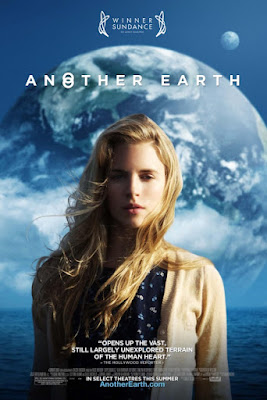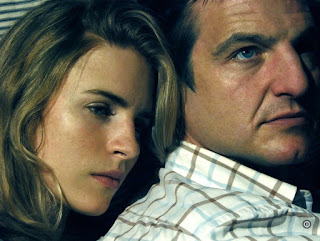Let's just say for a minute that there's a parallel universe and a Twin Earth that somehow became aware of us. How would these other-earthlings make themselves known to our world?
Depending on how they'd be able to interface with us, they might probably try sending out messages through mediums - artists, sensitives, what have you. After all, we've hundreds if not thousands of schizoid rants going on about a parallel reality and parallel earth, but no one's paid much attention to the direct approach.
Now, stop to think about the stories we tell ourselves - and tell our children - for a minute. Think about how many of them are about intense childhood trauma acting as a portal to another dimension.
• Alice in Wonderland is about a child falling down a hole and being poisoned with disfiguring drugs before finding herself in another reality.
• Peter Pan was inspired by the death of JM Barrie's brother, who was reborn as an eternally-youthful magical child. That story also winds up in another reality (Neverland),
• The Wizard of Oz is about a girl trapped in a horrible windstorm and ending up in another dimension.
• The Chronicles of Narnia is about children fleeing the London Blitz and ending up in another dimension.
• A Wrinkle in Time is about a girl who goes searching for her missing father and ends up in an entirely different reality. Incidentally, another reality ruled over by an entity called Central Central Intelligence.
• Star Wars is about a young farmhand who is brought into another world (or worlds) after the gruesome death of his guardians.
• Harry Potter is about an abused young orphan who enters into a parallel reality.
• Fringe is about an abused young girl who is given strange drugs by Harvard doctors and becomes able to cross into other dimensions as an adult.
• Stranger Things is about a girl stolen from her mother and subjected to hideous experiments. She ultimately creates a portal to another dimension.
• The OA is about a blind orphan who enters another dimension during a near-death experience.
Are you sensing a thruline here? Where does that motif come from?
Given the pedigree of some of the people involved here, you think these stories might be a reflection of some kind of secret ambition on the part of certain factions?
You think it's mere coincidence that most of these stories involve vulnerable young girls? And drugs? And intelligence agencies?
Think about that for a while.
Anyhow, while I enjoy some of the episodes, I’ve come to believe that Fringe was a sinister show. Like Stranger Things 2 and more movies and TV series than one can name, Fringe plays out like a whitewash of some very malevolent shit.
Through clever misdirection, it’s almost as if the producers of Fringe sought to reframe decades of illegal experimentation on children as being an attempt to create a race of X-Men with super-magical mind powers.
More recently, I've come to wonder if Fringe weren't also designed to trigger sleepers from those old 70s programs through some kind of signaling or suggestion. This isn’t too far a stretch, since that very theme is explicitly and repeatedly played out through Fringe's first season.
Now, I haven't looked too deeply into other possible cases, but I can't help but think of how Amy Bishop's shooting rampage at the University of Alabama Huntsville could have triggered by episodes of Fringe called "The Bishop Revival" and "Jacksonville."
Especially given the shootings - which were even weirder than most plotlines you see in Fringe (two words: herpes bomb), happened just a few days after Jacksonville - an explicit MKULTRA narrative about the deliberate scientific torture of children - aired.
Do note that Amy was on the "gifted program" track and included a quote from Through the Looking Glass in her high school yearbook entry.
Sometimes the conspiracy theories write themselves.
- Fringe is explicitly playing off that very long line of stories about traumatized children who have the power to access other realms or dimensions.
- In fact, Fringe explicitly argues that it was precisely the drugs and trauma that Olivia Dunham was subjected to that gave her these wondrous powers to cross through worlds.
- The result of Fringe’s particular experiments is that the basic fabric of reality in a parallel universe becomes unfixed and unstable, exactly because of people crossing over from our reality to theirs.
Simply put, I don't believe any of the science in Fringe. Having followed the press releases of the theoretical science special interests (including DARPA) for the past three decades I've seen a lot of stuff that exists on paper and nowhere else, and probably always will.
Fringe presents a world in which science and technology can do nothing for any of us but make our lives worse.
It's a world in which elite corporations monopolize the tools that control our lives and no one but the disgruntled minions of those corporations can break that monopoly and usually do so only to our detriment.That's not escapism, that's the same shitty situation we face every single day.
- Anna Torv's family is mostly Scottish, and her family was originally from the same county as Elizabeth Fraser. Twenty minutes down the road, in fact.
- Torv grew up in Gold Coast, Queensland, the place where Jeff Buckley and Joan Wasser were nearly swept to a watery grave in 1996 during a midnight swim in the notoriously treacherous waters.
- John Noble, who plays Walter Bishop on Fringe, appeared in the Lord of the Rings films, debuting in The Two Towers. Elizabeth sang twin songs for that score, "Isengard Unleashed" and "Lament for Haldir."
- Joshua Jackson, who plays Peter Bishop, costarred in Cruel Intentions, which used a song Elizabeth sang ("This Love") for its soundtrack.
So aside from the actress who plays the woman who can cross between worlds hailing from a family literally right down the road from Elizabeth Fraser's childhood home, the other Fringe stars worked on two of the very few films she worked on soundtracks for.
Hello? Is this thing on?
Anyhow, as these kinds of details pile up in an Everest-sized stack, I can't help but wonder if we're seeing the same thing depicted in Fringe in our current situation: the fabric of reality has been rent because something from somewhere outside of it - a parallel universe, perhaps - crossed over back in the Eighties and took up residence inside a deeply-traumatized teenaged runaway with the voice of an angel.
I'm no physicist, but maybe that explains all this.
Intense childhood trauma - and adult trauma, in this case - cracking open dimensional portals was also the thruline in the second season of The OA, a show I wrote quite a lot about (you can read all about it in The Endless American Midnight).
Here's a breakdown:
In The OA, an alternate dimension expands the show’s mythology into a full-blown multiverse concept.This season builds on the first season’s ambiguity about Prairie Johnson’s story—whether her tales of near-death experiences and other dimensions were real or delusions—by confirming that these alternate realities exist and can be accessed.After Prairie dies in her original dimension at the end of Season 1 (shot during the school incident), her consciousness jumps into this new reality, inhabiting a version of herself who never went blind, wasn’t adopted, and lived a very different life as a wealthy Russian medium.The parallel world operates under the show’s multiverse rules: each dimension branches from choices or events, creating distinct timelines. Here, Hap continues his obsession with interdimensional travel, experimenting with NDEs and a strange house that seems to connect realities via a rose-tinted window—a literal portal glimpsed in dreams and visions.
Brit Marling isn't your typical Hollywood airhead of the week. She was class valedictorian at the elite's elite Georgetown University and an intern at Goldman Sachs (who later offered her a full-time position). This is an extremely intelligent woman plugged into the very upper reaches of imperial power.It shouldn't surprise us then that she is involved with Sir Ridley Scott, who produced her feature film The East (co-written with collobarator Zal Batmangilj) in which she plays an intelligence agent sent to infiltrate a ecoterrorist group.
She also played an American enlisted to head Scotland Yard's PR department in the British miniseries Babylon (created by Oscar-winning director Danny Boyle).Add in her supermodel looks and you start to wonder if Brit Marling wasn't in fact grown in some CIA lab somewhere. Especially when you factor in the ever-present themes of secret societies, cutting edge science and espionage in her work.
But still, here's the full skinny on its otherworldliness:
In Donnie Darko, a Tangent Universe is essentially an alternate, unstable version of reality that branches off from the main universe (called the Primary Universe) due to some kind of cosmic glitch or anomaly.
In the film, this anomaly happens when a jet engine inexplicably falls from the sky and crashes into Donnie’s bedroom on October 2, 1988.
According to the story’s internal logic, this event shouldn’t have happened—it’s a break in the natural order of time and space. When it occurs, it creates a parallel timeline, the Tangent Universe, which is doomed to collapse within a short window.
The Tangent Universe is inherently unstable because it’s not supposed to exist. If it isn’t corrected, its collapse could destroy the Primary Universe too, ending everything.
Again, I didn't need to know any of this to love this film. But knowing it certainly helps in solving these larger mysteries.
Next up we'll look at Stranger Things, Annihilation, Silent Hill and much more. Don't you dare miss it.
After years of foreshadowing, Dawn was introduced at the start of the fifth season as part of a large in-story retcon: Characters accepted Dawn's presence as if she had always been there, and as if Buffy always had a sister, with only the audience aware that this was not the case.
As the series went on, the significance of Dawn's arrival is revealed to the series's other characters, and they come to understand that she has not always been Buffy's sister, or indeed a sentient being; Dawn had originally been the mystical "key" to unlocking dimensions and was made into Buffy's sister so the Slayer would protect her.
Dawn suffers more pain when her mother (Kristine Sutherland) dies unexpectedly from a brain aneurysm, which leads to Dawn resorting to black magic to try to bring her back from the grave, an action she immediately reverses upon realizing the consequences of her actions.
It is eventually revealed that Dawn's purpose as The Key is to open portals to alternate dimensions — a power the hell-god Glory wishes to exploit to return home.
When Glory successfully uses Dawn's blood to break down the dimensional barriers, Buffy sacrifices her own life (realizing that their blood is now the same) to end the apocalypse and save Dawn; Buffy's sacrifice also neutralizes the power of The Key, giving Dawn the opportunity of a normal life.
• • • • • • • • • • • • • • • • • •
It's not too late to make 2025 the year you master the Art of Sync. Check out this action, Jackson:
The Secret Sun Synchromystic Handbook is the world's first instruction manual for understanding and using the full scope of synchronicity in your daily life.
The Secret Sun Synchromystic Handbook is a comprehensive guide to learning and using the tools and techniques of Synchromysticism, based on the art of recognizing and understanding meaningful coincidence.
The Secret Sun Synchromystic Handbook explains how you can methodically evaluate and utilize synchronicity, using a detailed set of criteria that will help separate signal from noise and revelation from delusion.
Click for Print book
Click for Kindle












